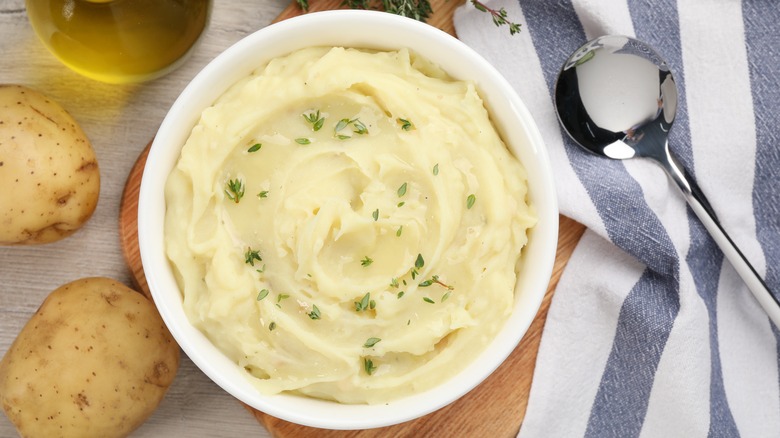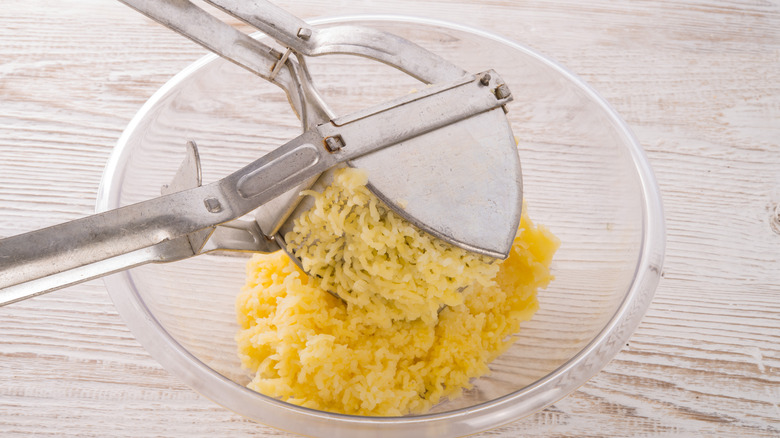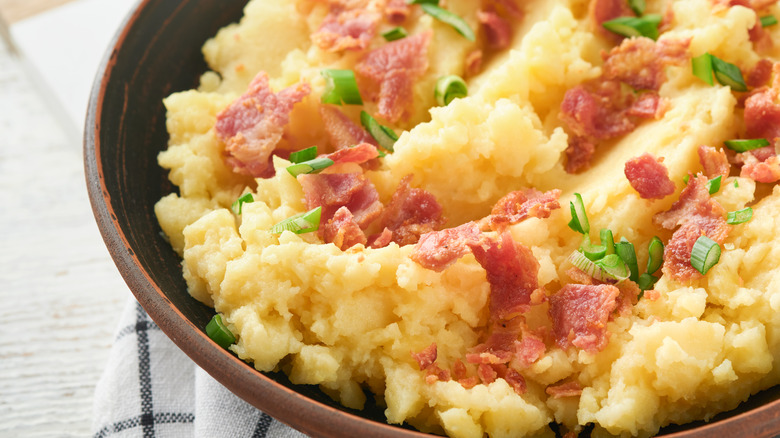The Best (And Worst) Kitchen Tool For Mashing Potatoes
You can't go wrong with mashed potatoes for a hearty weeknight supper or an extra-special holiday meal. This side dish seems straightforward enough, and certainly isn't hard to make, but the key to creamy, dreamy mashed potatoes is using the right tools. As it turns out, some of the easiest appliances to use produce the worst end results.
A gluey, gummy, and sticky texture is a hallmark of a mash made the wrong way, and the worst thing you can do is purée the potatoes in a food processor or blender. You may think that blending will get you an ultra-smooth product, not to mention it's is as easy and quick as the press of a button, but these tools are so powerful that they zoom right past by silky potatoes and go straight into gummy territory. The high-powered blades break apart the potatoes' starch molecules very quickly. Too much starch is released into the mixture, resulting in a texture that is paste-like, dense, and just plain sad.
Instead, reach for a ricer or food mill to produce creamy and light potatoes. A stand mixer or handheld electric mixer can also yield a fluffy mash, when used with more caution. And while a potato masher seems like an obvious choice, and it does get the job done, it presents a pitfall that you need to carefully avoid.
The best tools to make lump-free mashed potatoes
Making the best mashed potatoes starts with choosing the best potatoes, and knowing which ones you should avoid. The safest bet is to opt for starchy or "all-purpose" spuds. Just boil them in salted water until fork-tender before proceeding with your mashing tool of choice.
A ricer is a tool that works like a giant garlic press. You sandwich potatoes between the "jaws" of the ricer, then press the handles together to extrude perfectly smooth strands of potato into your mixing bowl. Any skins will be left behind, which saves you time spent peeling the potatoes. A food mill can also help you create a super-smooth mash. It works by pressing cooked potatoes through the small holes of a perforated bowl, and is operated via hand crank. You also don't need to peel your potatoes for this tool, and it can handle a larger batch than a ricer.
A handheld mixer or stand mixer isn't quite as efficient as a ricer or mill, but you're more likely to have these tools already in your kitchen. Just don't whip the potatoes on a high setting, mix them in short intervals, and stop before they turn from rich and creamy to gluey and plaster-like. The margin of error here is slim. One more tip: Make sure the butter, milk, or cream you add to the potatoes is warm, so they blend into the mash easily and don't require you to overmix.
The right tool for chunky mashed potatoes
If you prefer your mashed potatoes a little chunky, a ricer or food mill might not be the top choice for you. A very smooth mash may be delightful alongside a seared steak or grilled shrimp, but a more robust and chunky texture might better stand up to braised short ribs, or as the topping on shepherd's pie. This is where a regular old potato masher comes in. You need to put in some elbow grease to mash the spuds this way, but it does give you more control over the texture of the final dish.
With that being said, working the potatoes too much using a masher can still result in unpleasantly sticky mashed potatoes. To avoid this, cook the spuds until they are fully tender. Then, after draining, mash them in a wide-bottomed pot or large mixing bowl. You want the potatoes to be arranged in one layer, or as close to that as possible. You can mash them all easily without having to press down on them again and again, trying to squash spuds that are hidden under others. This is what can lead to gluey potatoes before you know it.
Once you've mashed your spuds, the hard part is done (and it probably wasn't even that hard). Now you can have fun with tasty ingredients that will change the way you make mashed potatoes, like roasted garlic, crumbled bacon, or fresh scallions.



